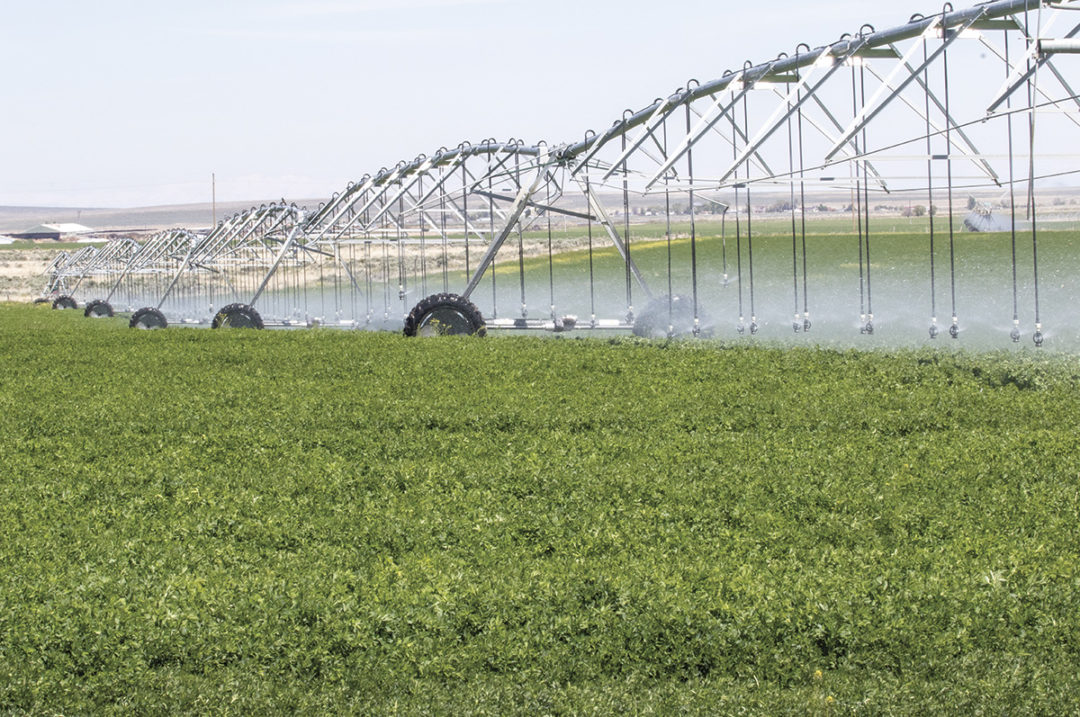Idaho Irrigation Pumpers Association Inc. has one job – to ensure a reliable power supply at a reasonable cost for Idaho’s irrigators. “We’re intervenors,” says Mark Mickelsen, current president of the organization. “We protect irrigators as a class of power users, providing rate protection where it’s applicable.”
Mickelsen gives an example: “For instance, if there’s a 3,000- to 4,000-HP pump, or even a 600-HP irrigation pump, pulling power, it’s cheaper to deliver to that single pump than to all the infrastructure needed to deliver the same amount of power to a residential development. So the costs to the irrigation pumper need to be lower in that instance, and they need to not be burdened with the higher rate covering the added infrastructure.”
What exactly is an intervenor? “Well, it usually involves legal counsel and engineering specialists,” Mickelsen says. “When we intervene [in a power rate case], we use our attorney and a power specialist that helps interpret the data and make sure we’re not being charged with things that do not deal with irrigators.” The group itemizes specific items that relate to the rate costs, from transmission to power production, to determine the appropriateness for the irrigators.
“When power companies ask for rate increases, our legal and engineering specialists come together to make sure the rates are aligned with our costs for delivery. This provides information to the Public Utilities Commission [PUC] so they can make proper decisions as to what they will accept for irrigation costs,” Mickelsen says. When the PUC finds the information useful, PUC will return some of their costs in protecting the irrigators’ rates.
“Over the last 30 to 40 years,” Mickelsen says, “we’ve been a large part of what keeps our irrigation costs down. We don’t try to bring things in that are not correct – we bring information and help with evaluation to make sure we’re being treated equally according to circumstances.”
The group is funded by contributions, and those who serve in the organization (on the board of directors) are volunteers. Contributions are not categorized as donations in individual tax statements, however, but as costs of business.
If there’s one misconception about the group, Mickelsen says, it’s the mistaken belief they get involved in water rights. “That’s not the case,” he simply says. Their purpose is to watch out for the irrigators’ interests as a class of power users.
The Idaho Irrigation Pumpers Association has also had significant input on programs like Irrigation Peak Rewards, which is a program run by Idaho Power whereby an irrigator can elect for Idaho Power to remotely turn off an irrigation pump for a few specific hours when summer energy demand is high. Shutdowns might be three times a year or 15 times in a year (not to exceed more than 60 hours per season) to help equalize power grids and facilitate fewer rolling brownouts. Farms can also opt out at certain times for any reason. In return, farms receive incentives – a demand credit and a kilowatt-hour (kWh) credit. Generally (although not always possible), Idaho Power can provide notification four hours before each event for participants via text, email or phone, at the customer’s preference.
“For the Irrigation Peak Rewards program’s upcoming season, Idaho Power has proposed both operational and incentive changes to the program,” says Sid Erwin, vice president of Idaho Irrigation Pumpers Association. Idaho Power has filed for tariff changes with the Idaho and Oregon Public Utilities Commissions to lengthen the season to Sept. 15, change the event window to later in the evening, increase the incentives, change the threshold from three to four events for when the variable incentive is paid, modify the opt-out penalty for events after the first three, and open enrollment to all agricultural irrigation customers. These proposed program modifications address changes in Idaho Power’s electrical system need and operations that have occurred since the Demand Response Settlement Agreement that was approved in 2013. These proposed modifications are the result of analysis Idaho Power did while developing its 2021 Integrated Resource Plan.
Irwin says changes are expected to be approved in early March, and after that Irrigation Peak Rewards enrollment packets will be sent to irrigation customers. The packet will contain an informational brochure, enrollment worksheet and a contact worksheet. For all new pump sign-ups, a demand response unit will need to be installed by an Idaho Power-contracted electrician prior to June 15, 2022.
Rocky Mountain Power has a similar demand-side management program called EneIX. The Idaho Irrigation Pumpers Association is in the process of working with specialists to drill down into what irrigators should be paid for these power interruptions.
“I don’t know of another organization that does what we do – to step in for the irrigators,” Mickelsen says.
Mickelsen farms in Bonneville, Jefferson and Fremont counties, growing mostly potatoes. He (and other board members) spends a fair bit of time as a volunteer. “I have good help on my farm and can volunteer some time for the organization,” he says.



.jpg?height=auto&t=1713304395&width=285)


